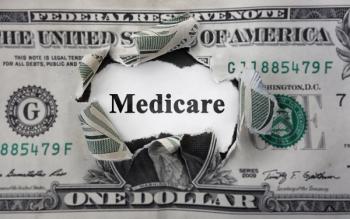
What health care could learn about information sharing from banks and retail stores
Economist discusses potential cost savings and fewer administrative burdens if U.S. health care had an automated clearinghouse.
American banking and retail sales have two large-scale processes that could serve as models for a new, standardized way to share information about patients and their health care.
U.S. banks have an automated clearinghouse that standardizes financial transactions to transfer money across the street or across the nation. Different stores sell identical products in packaging that bears Universal Product Codes, the black lines that make it faster to track inventory and scan items at cash registers. Those examples show it is possible for competing companies to share information in a way that benefits the business and the customer.
Cutler outlined a plan for a
Cutler spoke to Medical Economics about lack of standardized information in health care, how a clearinghouse would work, and how it could streamline the prior authorization process. This transcript has been edited for length and clarity.
Medical Economics: Your policy proposal mentioned health care does not use standards as consistently as other markets. Why is that historically? And why does that remain the case today?
David M. Cutler, PhD: I think partly the lack of use of standards is because there was no big centralized organization that says, these are the standards you must use. And I contrast that with banking, where in banking, we said, if you want to transfer money to other banks, these are the standards to use. The Federal Reserve said that and a consortium of private banks said that and you can decide you don't want to transfer money electronically, in which case, nobody wants to go to you, but you can decide you don't want to do that. But if you want to do it, this is how you're going to do it. And I think that that kind of thing has not happened yet in health care, where CMS (the U.S. Centers for Medicare & Medicaid Services) could do that or a consortium of private insurers could do that. Just say, this is the way it's going to happen and we're going to use these standards. The result is the federal government sort of very sporadically and very slowly puts in place standards but never fast enough and never with enough force to make people clearly have to do it. So, we're getting a little closer with things about standards by which insurers can access data from individual providers, but it's still not where we need to be in terms of, no, this is how it will be done.
Medical Economics: Your paper included a design and a description of a health care automated clearing house. How would that work?
David M. Cutler, PhD: The automated clearing house, it's really got two parts to it. One, in banking, it transfers money from one bank to another. And second, it's got standards in terms of what you need to feed into it. So literally, like you feed in exactly data in this order, and then it happens. And that's what you need in health care, too. So, the automated clearing house would be, OK, this is the information you're going to transfer and this is how it's going to be transferred, the specifics about it. And so you'd have a standard-setting organization alongside transmittal organization. What we've seen, unfortunately, with Change Healthcare (cyberattack), that was a big deal. That wasn't the only platform, but it was one of the big platforms it was a very big deal and it wasn't secure, whatever it was, so it got hacked and so on. When you just rely on decentralization to do this, that just doesn't always work. In one way or the other when things go bad, the government is going to be involved, so you better have the government be involved, or someone who's acting like a government, you know, private firms that are saying, no, no, we'll take this on and we'll make sure it works, actually like a government, to say, this is how it’s going to operate. I think that that's a good model.
The Universal Product Code is also a good model. There was a group of stores, supermarkets, that said, look, we're going to go nuts if we have to type in the prices for everything. Why don't we just say, look, if you want to sell in our stores, you’ve just got to have this barcode, and this barcode is going to take care of everything. And then it doesn't mean we have to have the same price for the thing. We can have different prices for the thing. It just means that we're going to call the thing, the same thing. You know, so this barcode is going to say exactly what it means, that the barcode means the same thing at one store as at another store. And so that's another example where big firms lead the way in terms of standardization. So, we've seen it through big firms, we've seen it through government, but one way or the other, that's the way it has to happen.
Medical Economics: With a health care equivalent for an automated clearing house, how could that apply to prior authorization? How would that minimize that burden?
David M. Cutler, PhD: A couple of different ways. One is just simply standardizing what information is provided for a number of things. So, for example, some insurers say we'll do prior authorization, you know, based on this particular set of criteria, and others have a very slightly different set of criteria. And so you have to fill in the forms differently, rather than just saying, look, I just want one form. Maybe it has both of those things, but I just want one form. Literally it can just be pre-populated. You want to think about AI (artificial intelligence) is coming in and just saying OK, look, I can look in your record and I can pre-populate the billing form, so instead of someone filling it out from scratch each time, maybe 80 to 90% of it gets filled out right away. And so that's one way the standardization can help.
Another way is, even in that system, you still have the provider sending information to the insurer, the insurers looking at it, sending information back and then back again and then back again. Almost all that information is now electronic. It exists in electronic medical records. So, an even better way to do it would be the physician literally at her computer says I want to do X, that transmits something to the insurer, the payer, and then the payer can look inside the record and see yes, X is right here because all the conditions are met. And there's no reason that can't happen right away. You know, you can search for something and within a billionth of a second or whatever it is, 27 things like it come up. Technologically you can do that and then you could literally have a real time answer to the prior authorization with no individuals having to be involved. You don't have to have someone type up the form, enter all the information in the thing, fax it over, Xerox the medical records, fax it over. You can literally do all that stuff electronically and just cut out a lot of the people that are involved in it.
Newsletter
Stay informed and empowered with Medical Economics enewsletter, delivering expert insights, financial strategies, practice management tips and technology trends — tailored for today’s physicians.



















